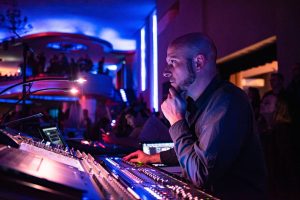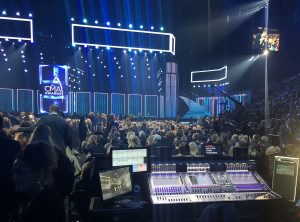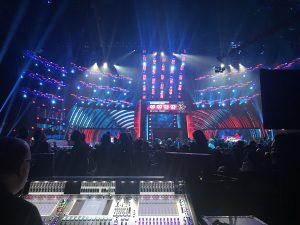DiGiCo Corrals Audio for Multiple Shows, National Christmas Tree Lighting; Murt Wheland Sound Buys Ireland’s First SD12 Console
Story Highlights
DiGiCo has been busy during the last couple of months, as the company facilitated audio for multiple award shows, music tours, and the National Christmas Tree Lighting. In addition, Murt Wheland Sound purhases the first SD12 console in Ireland.
 Desks Shine on Mike Shinoda’s Solo Tour
Desks Shine on Mike Shinoda’s Solo Tour
One thing that pretty much any experienced touring mix engineer can agree on is that you always pad your input/output number request to a certain degree because rare is the tour where those needs will not increase as the tour progresses. So it might seem odd that when the current Post Traumaticsolo tour by Linkin Park’s Mike Shinoda got started, mix engineers Mike Fanuele and Kevin “Tater” McCarthy were sharing a single DiGiCo SD12 mix surface.
After that first show, the SD12 was shipped off for the tour’s Asian and European legs, and McCarthy, who has been associated with Shinoda for more than a decade, spec’d a pair of DiGiCo’s ultra portable SD11i desks for the promo tour that preceded the Asian dates. He says he’s fielded more than one question about why he made that choice.
“A lot of people have asked me why I choose the SD11i,” he reports. “Originally, it was just Mike Shinoda and no other band members. The band and additional crew where added after all of the gear had shipped to Hong Kong for the Asian and European tours. After a few shows, I was comfortable with the all the new inputs and with the 12-fader format, so I decided to keep it. It never came off that table rack. I just popped the lid every day and was ready to go.”
Fanuele is on his first outing with Shinoda after working with a wide variety of artists ranging from Meghan Trainor and Fifth Harmony to The Chainsmokers and Garbage. “Mike began this tour cycle on stage by himself playing keys, synth, drum pads, and triggering samples from a Maschine,” he says. “For the first show, he actually performed on a satellite stage near FOH, where Tater and I both mixed off of the same SD12 console. I took the left side of the desk and fed my mix into an LM44 and then out to the PA, and Tater took the right side of the console, where he mixed Mike’s IEMs. It was a unique experience, but the flexibility of the surface proved perfect for the task, and we were both able to manipulate the workflow to match our needs off of one console.”
After Shinoda added drummer Dan Mayo and multi-instrumentalist Matt Harris, the input count went way up. “It kind of skyrocketed,” McCarthy recalls. “We were utilizing approximately 52 inputs between both desks running in an optical loop. So we had one SD-Rack located in monitor world, which was loaded with seven Stadius 32-bit mic pre-amp cards, five Stadius 32-bit DAC cards, and one AES card. On my end of the snake, there were eight stereo mixes feeding Shure PSM1000s for three band members, guests, and techs. There were also three additional mixes of conventional speakers — two DAS Road 12A wedges for guests and two DAS Event 121As for stage subs.”
Fanuele moved between a few different DiGiCo surfaces over the course of the tour, which just finished a US leg before heading back to Europe for additional dates. He manned an SD12 for the first Asian leg, moving to an SD10 for the US leg. “Both Tater and I were very impressed with the power, flexibility, and performance of the SD11i. But as the tour continued to evolve, I needed additional faders and moved to an SD12 at FOH for the Asian and European legs of the tour,” says Fanuele. “I quickly fell in love with the surface. It is extremely comfortable to work on, and when considering size versus surface flexibility, I think the SD12 is a complete homerun. Again, we were playing venue sizes from clubs to smaller arenas to stadium festival gigs, and the size of the SD12 fit into all of those situations.”
The FOH engineer reports that McCarthy was in control of the Stadius 32-bit mic pre’s, while he controlled the AES output card and the Stadius 32-bit DAC cards, which were included to provide flexibility in distributing the house mix to PAs from the stage when needed. McCarthy says he loves what some might see as a side benefit of having all of the audio on a loop: that loop can contain more than just audio. “Mike and I could communicate between ourselves by sending text messages directly from the consoles.”
“Overall, I think the flexibility of the surface and the sonic detail of the pre’s and outs made DiGiCo’s SD-Range the obvious choice for the tour,” says Fanuele. “The initial promotional portion of the tour had us mixing everything from in-store performances to stadium festival gigs. The SD11i allowed me to fit in all spaces, whether that meant squeezing into a busy FOH area for a festival or if I found myself in the middle of a display rack for CDs. I was able to keep the consistency of the mix that Mike was looking for in all situations.”
 Consoles Keep The Country Music Association Awards Covered
Consoles Keep The Country Music Association Awards Covered
The 52nd Annual Country Music Association Awards ceremony, held on Wednesday, November 14 at Nashville’s Bridgestone Arena and hosted by Brad Paisley and Carrie Underwood, recognized the best in country music released during the CMA’s annual eligibility period. Winners included Entertainer of the Year Keith Urban and Song of the Year “Broken Halos” by Chris Stapleton, who also garnered the Male Vocalist of the Year award.
Everyone who heard the show’s 22 music performances and awards introductions by those artists and others listened to them through a pair of DiGiCo SD-Range consoles: an SD7 helmed by Blackhawk Audio President Rick Shimer at FOH for the event’s music performances, and an SD5, which mixed the evening’s production audio, piloted by ATK Audiotek Principal Pat Baltzell. The house audio was played through a JBL PA using a combination of VerTec 4889 and VTX V20 enclosures.
“Rick and I have done this show for nearly 20 years, and the SD consoles have made a huge difference in both the house sound and the workflow,” says Baltzell, who was also the sound system designer. “We split the sound between us — Rick handles all of the music mixes from the stage, while I do the production mix, which is all of the audio elements other than the music: the awards introductions, acceptance speeches, video rolls, and so on. We’ve found that division of labor to be the most efficient workflow.”
Baltzell notes that the DiGiCo SD5 console, with 253 input channels and up to 124 aux and subgroup busses, might have seemed like overkill for the relative handful of microphones used for the awards presentations, versus the order of magnitude larger number of inputs that came close to maxing out the SD7 console at FOH. However, he notes that in addition to the production audio for the show, his SD5 console was also the fail-safe hub for the entire production.
A separate music feed was being continuously sent from the SD7 at FOH to Baltzell’s SD5, in the event that there was an interruption in the feed from front of house to the broadcast truck, it could be switched over instantaneously. And in case the signal path from the venue to the Denali broadcast truck failed, Baltzell could route the audio for the entire production directly to the satellite uplink truck.
“As a result, the SD5 was taking on the potential for much greater responsibility for the event,” he says. “That’s one of the reasons I chose it — I knew it could handle that kind of pressure. It has tremendous capacity to do a lot of things simultaneously, and do them all well.”
While, thankfully, no such emergencies occurred and the event went smoothly, Baltzell said he was happy to have DiGiCo’s EQ and multiband compressors at his fingertips, because awards shows often have unique audio quirks and the CMA Awards are no exception. For instance, there are Meyer MM4 compact speakers built into the steps leading to the stage used to cover the first row of seating, and every other seat in the first row has a JBL Control 25 speaker positioned under it to compensate for the higher-than-usual line array hang used to keep the stage sightlines clear.
“As a result, I don’t put the production audio into the bottom three speakers in each array, to create a buffer area around the podium microphone,” Baltzell explains. “The SD5 is able to zone all of that and let me dial in exactly the EQ I need for each of those speaker locations. And unlike years ago when most of the announcers were men, now we have a lot of female presenters, so for that I’m using the de-essing capability on the equalization to keep the sibilance out of the mix. I have a dialog rack that has a few outboard processors that I love to use for this type of work, but having the kinds of options the SD5 gives me is very helpful.”
And for a console that has to keep the speech supremely intelligible throughout the performance, but could be called on at any moment to be a music desk, the SD5’s sonic quality is another reason Baltzell chooses DiGiCo. “We were able to do strictly 96 kHz on this show for everything, including the monitors, and I have never heard a music show sound better than they do on a DiGiCo desk at 96k,” he says. “The sound is so clear yet has plenty of depth. On a big show like this, DiGiCo makes all the difference.”
 ¡Un Sonido Increíble! for Latin GRAMMY Awards
¡Un Sonido Increíble! for Latin GRAMMY Awards
The 19th Annual Latin GRAMMY Awards Show, held on November 15 at the MGM Grand Garden Arena in Las Vegas and broadcast live on Univision, brought together Latin music’s future and past, presenting a broad array of genre options, from the mainstream pop of Korol G and J Balvin to the cerebral lyricism of Jorge Drexler, who garnered this year’s Song of the Year and Record of the Year.
What they all had in common was amazing audio, thanks to the deployment of four DiGiCo consoles for the show: two SD7 desks for front-of-house music and production, and two SD10 consoles for monitors, along with a total of eight SD-Racks, all supplied by Firehouse Productions, whose VP Mark Dittmar and system technician David Crawford designed the event’s sound system, with Luis Espinal also serving as a system tech. Front-of-house music mixer Ron Reaves and production mixer Andrew “Fletch” Fletcher both used SD7 consoles, while monitor mixers Mike Parker and Mike Bove used the SD10 desks.
“The DiGiCo consoles are a very powerful platform to work from on shows like this, where the engineers are potentially confronted with complex workflows,” explains Dittmar, who also assigns DiGiCo desks for Firehouse Productions’ support of the GRAMMY Awards and the Video Music Awards shows, among other broadcast events. “The SD consoles have so many features that make workflows simpler and let the engineers focus on the sound. For instance, we used the remote iPad feature on the SD10s at monitors, which really let the engineers focus on what each artist on stage needed, and let them and their teams get things like in-ears set up properly and quickly. The SD consoles also let you work in the domains you want: we traditionally do analog splits between consoles, and each desk has its own set of SD-Racks, and there’s never an issue there. They’re just rock solid no matter how you use them.”
Reaves, the veteran FOH music mixer for the GRAMMY Awards and the Latin GRAMMY Awards shows, says the SD7 equipped with the WAVES plug-in package he helmed for the house music mix is the perfect choice for award-show gigs. “The Latin GRAMMYs are a little different from the regular GRAMMY Awards shows in that most of the artists use tracks to some extent, and the challenge is always to match the live vocals to those tracks, which tend to be highly compressed, loud, and with few dynamics left in them,” he explains. “When you put a live vocal through a great microphone up against them, the sonic differences are often jarring. That’s where the DiGiCo console really shines, though. I really get into using the onboard compression and the dynamic EQ features. Between those, I don’t have to use any plug-ins at all, which also helps keep the workflow nice and simple, which is important on a live show. This is a lively, fast-paced, and upbeat show, and you really have to pay close attention as it moves along. I couldn’t imagine using anything but a DiGiCo for it.”
Fletcher used an SD7 to bring 56 inputs of introductions, acceptance speeches, stage patter, and music bumpers into the house. These came everywhere from the four podiums on stage (two wireless and two pop-ups, the last a backup podium) for the event hosts Carlos Rivera and Ana de la Reguera, four handheld microphones, and a full music backup of Reaves’ console. “That’s one more thing that you always want DiGiCo for — the redundancy,” says Fletcher. “The SD7 has two complete engines, and I know that if there’s ever a problem, it will be a seamless transition from one to another. It lets you focus all your attention on the show, which is where it should be.”
 America’s Christmas Tree Lighting Ceremony
America’s Christmas Tree Lighting Ceremony
On Christmas Eve, 1923, President Calvin Coolidge walked from the White House to the Ellipse and pushed a single button to light a 48-foot Balsam fir—the first National Christmas Tree—as enthusiastic spectators looked on.
On November 28 of this year, however, there were a few more buttons to push as monitor engineer Sven Giersmann piloted a DiGiCo SD10 console — provided by Maryland Sound, the event’s audio supplier for over a decade — for a large and diverse array of musicians who performed at this year’s lighting of the National Christmas Tree. Hosted by actor Antonio Sabàto Jr. and aired on the Ovation and REELZ channels the following Sunday, the 96th annual production featured a diverse lineup of performances from Abby Anderson, Anthony Kearns, the Dominican Sisters of Mary (a.k.a. “Caroling Angels”), Gabby Barrett, John Driskell Hopkins, and Joe Gransden, LOCASH, Matthew West, Paul Cardall, Spensha Baker, Thompson Square, and the United States Army Band, ‘”Pershing’s Own.”
“The show has multiple performance spaces and is live to tape, so there was a lot to manage,” recalls Matt Snyder, Maryland Sound’s account executive on site. “Some of the artists performed on their own, others played with the U.S. Army Band, plus we had a number of different hosts on stage throughout the event, and we had a constant mix of both in-ears and wedge monitors. The SD10 was maxed out, but it handled everything flawlessly.”
The SD10 was used in conjunction with a pair of SD-Racks on an optical loop, clocking at a pristine 96 kHz, to manage 34 handheld wireless microphones, 20 stereo IEMs, and even more floor mixes. In addition to 96 stage inputs, multiple stems and truck feeds to performers were routed through the SD10 monitor console.
“None of the small format consoles in the inventory could handle the I/O capacity of this show,” Snyder adds. “The SD10’s intuitive workflow was critical and, because of the remote location of the console, the iPad app was also an essential system tool. With only one-timed rehearsal before the broadcast, Sven had to generate and edit snapshots on the fly, and the SD console software lets us do that easily.”
Murt Whelan Sound Invests in Ireland’s First SD12
With a burgeoning Irish music scene and ever-increasing demand for rider-friendly consoles, Murt Whelan, owner of the eponymously named Murt Whelan Sound, decided to invest in DiGiCo, choosing an SD12 as his first console from the brand and the first SD12 in Ireland. It proved so popular, that he quickly decided to add an SD10 to his inventory.
“Investing in DiGiCo has worked very well for us,” says Whelan. “Ever since we took delivery the SD12, it’s been our busiest console and has been pretty much constantly out on hire, either for shows we’re working on or for dry hire to other rental companies. It’s been out with Irish bands Gavin James Walking on Cars and Picture This, on the Féile Classical Festival, Independence Festival in Cork, and for the Trinity Summer Series in Dublin.”
As the only SD12 in Ireland, the console has proved exceptionally popular and proving that this is no fluke, since Murt took delivery of his SD10 at the beginning of September, it has been equally hard-working. In fact, he is in the enviable position of not expecting it to spend much time in the company’s warehouse.
“We immediately had several enquires for sub-rental for the SD10, and it’s also booked to go out regularly for the next year, which is exactly how you want it to be,” he smiles. “The market for DiGiCo in Ireland is growing very rapidly and the SD12 and SD10 have given us a very definite advantage.”
Murt purchased both consoles through SSE and, despite this being the company’s first experience with DiGiCo, they have not required training on the consoles.
“We just spent some time with the SD12 in the warehouse,” he says. “I did a show on it myself, having only spent an hour with it in the warehouse. I found it really easy to get around. Both DiGiCo and SSE offer amazing support and we know they’re there if we need them, but so far that hasn’t been necessary. The consoles are very intuitive but also, as you would expect because they’re so popular, a lot of our engineers have used DiGiCo before, so it was very easy to get everything set up.”
So pleased is Murt with his investment that he’s already planning to add more DiGiCos to his inventory.
“I’ve been really impressed with everything, from the fast turn round on deliver to the fact that they are there as a brand to support should you need it,” he concludes. “We are definitely planning to expand our DiGiCo stock in the very near future.”
